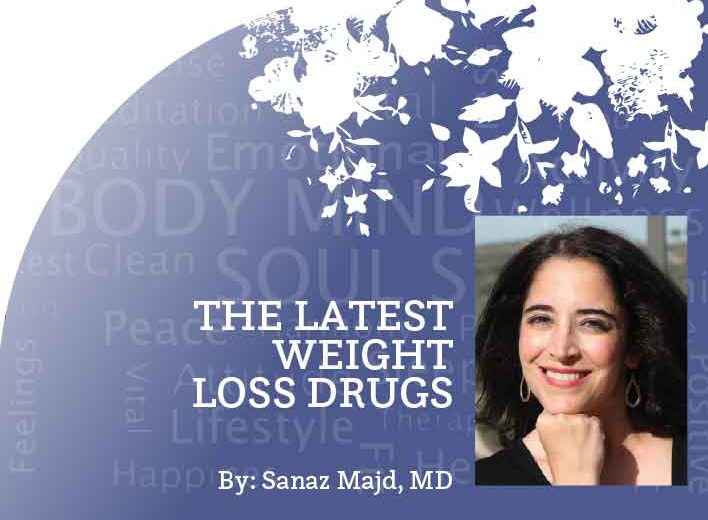By Sanaz Majd, MD
The media has glorified vitamin D, often referred to as the “sunshine vitamin,” and labeled it the cure-all for seemingly everything from depression to cancer and everything else under the sun (no pun intended).
Should you get your vitamin D levels checked or is it yet another media over-hype? Let’s review why vitamin D is important, who should get their blood levels tested, and how much is enough.

Why Do We Need Vitamin D?
Ingested vitamin D helps the body absorb calcium from the intestines into the bloodstream and is important for overall bone health. It also suppresses the parathyroid hormone that tends to break down our bones.
Insufficiency of vitamin D can contribute to osteoporosis—low bone density that can increase fracture risk. Fractures in later life, especially of the hip, can significantly impair quality of life and functioning.
What about the claims vitamin D can cure fatigue, depression, cancer, heart disease, etc? There is no good scientific evidence to back them up. Also, note that supplements are not FDA approved, so their safety is not always well-established and their claims often go unsubstantiated. The vitamin industry is quite savvy at marketing itself. So make sure to obtain the facts before you initiate any supplement, and pick your doctor’s brain prior.
What Are the Sources of Vitamin D?
There are two main sources:
YOUR DIET:
If you have watched my YouTube videos, you know that I always say it is best to obtain your nutrients from your diet rather than from a supplement. Dietary sources of vitamin D include fatty fish (such as salmon, mackerel, herring, and sardines), egg yolk, mushrooms, fortified cereals, and fortified cow’s milk. You can obtain around 100 International Units (IU) in an 8 oz. cup of milk , while 3 oz. of cooked salmon contains about 570 IUs. If you do not tend to consume these foods regularly, however, it may be a reason for vitamin D insufficiency and supplementation may be indicated.
YOUR SKIN:
Believe it or not, you also produce vitamin D underneath your skin when exposed to sunlight. Hence, why we refer to it as the “sunshine vitamin.”
However, the amount of sunlight necessary to produce sufficient amounts varies with location, season, and time of day. Peak sun rays are often between 11 a.m. and 3 p.m. And those who live in the northern latitude, above the imaginary line between Philadelphia and San Francisco, may have a greater challenge obtaining enough UV rays in the winter. Sunscreen may also limit vitamin D production (but that does mean we should forgo protecting ourselves from skin cancer).
Skin production also varies depending on the skin color and age of the person. Those who have darker skin may require more sunlight. Also, age is another factor—as we grow older, our skin production diminishes.
According to the National Institutes of Health (NIH), approximately 5 to 30 minutes of sun exposure either daily or at least twice a week to exposed face, arms, hands, and legs is typically sufficient for most people. But beware before you decide to fry your skin lathered in baby oil, as you do not want to exchange vitamin D for skin cancer, either. And tanning beds are certainly not recommended.
What Are Normal Vitamin D Levels?
One of the challenges of measuring vitamin D levels in the blood is that the expert groups do not agree on what “normal” levels should be—some say a level of 20 should be the threshold and others say 30.
Who Should Be Tested?
Severe vitamin D deficiencies are rare in developed countries like the U.S., but mild insufficiencies are fairly common. Some of the lowest vitamin D levels in the world have been found in people of the Middle East and South Asia, so Iranians are also at risk.
Infants/children and the elderly are two other at-risk groups, along with those who do not consume sufficient dairy products, have medical conditions that diminish the absorption of vitamin D through the gut, or medical conditions that impair vitamin D metabolism.
But, if you are relatively healthy and live in Southern California or other sunny parts of the world, should you even be worried about vitamin D levels since we tend to get more sun exposure? Who should be tested?
Not everyone needs their vitamin D level checked, despite all of the media hype. There is no good evidence that screening younger, healthy people is even beneficial. Because of this lack of available data, many insurance plans decline to cover the cost of the blood test and it is a very costly test (around several hundred dollars or so out of pocket).
Medical expert groups recommend testing of the following at-risk groups, the top populations that do have evidence to back up these recommendations:
Elderly people with falls, who are homebound, or living in nursing homes/long-term care facilities
People with intestinal disorders, such as Crohn’s disease and celiac disease, that affect the ability to absorb vitamin D through the gut
Those who have had surgery to remove any part of the intestines, such as those with gastric bypass operations
People with kidney or liver disease, organs which help metabolize vitamin D
Patients with osteoporosis or osteopenia diagnosed on a bone density test
How Much Vitamin D Do We Need?
The typical healthy adult needs about 800 IUs of vitamin D daily (for instance, elderly homebound patients may need more). Therefore, if you are a normal-risk adult, you do not necessarily need your blood levels checked, only to simply maintain this daily intake, whether it is through the diet or a supplement (or both).
Note that vitamin D does have a toxicity level, so do not take excessive amounts. However, up to 2,000 IUs daily have been generally found to be safe.
Supplements are sold in two forms—cholecalciferol (vitamin D3) or ergocalciferol (vitamin D2). D3 is preferred over D2, however, because it is the more naturally-occurring form of the vitamin with improved absorption rates.
In addition to vitamin D, calcium is a key player in bone health. For premenopausal women and men up to age 70, 1,000 mg of daily calcium (in divided doses) is also recommended. The recommendation is slightly higher at 1,200 mg for postmenopausal women and men over age 70. Again, it is best to obtain your nutrients through the diet, and calcium is found in many food sources.
As always, be sure to discuss your health with your doctor before initiating any medication or supplement, as this article is for general informational purposes only.
Wishing you a sun-sational Fall season!
For a video version of this article, check out @MajdMD on YouTube.
REFERENCES:
NIH: https://ods.od.nih.gov/factsheets/VitaminD-HealthProfessional/
USDA: https://www.dietaryguidelines.gov/sites/default/files/2020-12/Dietary_Guidelines_for_Americans_2020-2025.pdf
Sanaz Majd, MD, is a board-certified Family Medicine physician and host of the Majd MD YouTube channel, reviewing the latest medical topics and headlines: www.youtube.com/MajdMD. You can also follow her on Facebook or Instagram: @SMajdMD.


















